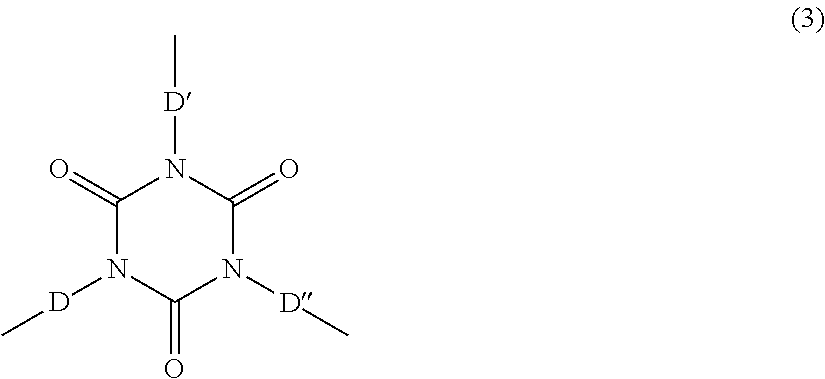Crosslinkable polyurea prepolymers
a technology of polyurea and prepolymer, which is applied in the field of crosslinkable polyurea prepolymers, can solve the problems that the combination of most desirable and most desirable combinations of contact lenses made from water-soluble photo-crosslinkable prepolymers may not always be desirabl
- Summary
- Abstract
- Description
- Claims
- Application Information
AI Technical Summary
Benefits of technology
Problems solved by technology
Method used
Image
Examples
example 1
[0171]Preparation of PEG-Urea Prepolymer. Place 400 grams of tetrahydrofuran (THF), 300 grams of water and 180 amine group milli-equivalents (meq) of Jeffamine® XTJ501 (Hunstman Chemicals) into a jacketed 1 L reactor and cool to an internal temperature of 0 to 5° C. with agitation. A solution containing 75 isocyante group meq of isophorone diisocyanate (Aldrich Chemicals) and 75 isocyante group meq of VESTANAT® T1890 / 100 (Degussa Chemicals) in about 60 grams of THF is added dropwise, with stirring, over a period of approximately 30 minutes. Stir the reaction mixture for a further 30 minutes whilst maintaining an internal temperature of 0 to 5° C. Three additions of 18 grams of sodium carbonate (20% aqueous), followed by 2.75 grams of acryloyl chloride (Aldrich Chemicals) are made with approximately 30 minutes between each addition, whilst maintaining an internal temperature below 10° C. Stir the reaction mixture for a further 30 minutes whilst allowing the internal temperature to re...
example 2
[0172]Preparation of PEG-Urea Prepolymer. Place 400 grams of tetrahydrofuran (THF), 250 grams of water and 150 amine group milli-equivalents (meq) of Jeffamine® XTJ501 (Hunstman Chemicals) into a jacketed 1 L reactor and cool to an internal temperature of 0 to 5° C. with agitation. A solution containing 99 isocyante group meq of isophorone diisocyanate (Aldrich Chemicals) and 21 isocyante group meq of VESTANAT®11890 / 100 (Degussa Chemicals) in about 80 grams of THF is added dropwise, with stirring, over a period of approximately 30 minutes. Stir the reaction mixture for a further 30 minutes whilst maintaining an internal temperature of 0 to 5° C. Three additions of 20 grams of sodium carbonate (20% aqueous), followed by 2.8 grams of acryloyl chloride (Aldrich Chemicals) are made with approximately 30 minutes between each addition, whilst maintaining an internal temperature below 10° C. Stir the reaction mixture for a further 30 minutes whilst allowing the internal temperature to reac...
example 3
[0173]Preparation of PEG-Urea Prepolymer. Place 400 grams of tetrahydrofuran (THF), 250 grams of water and 150 amine group milli-equivalents (meq) of Jeffamine® XTJ501 (Hunstman Chemicals) into a jacketed 1 L reactor and cool to an internal temperature of 0 to 5° C. with agitation. A solution containing 99 isocyanate group meq of trimethyl-1,6-diisocyanatohexane (Aldrich Chemicals) and 21 isocyante group meq of VESTANAT® T1890 / 100 (Degussa Chemicals) in about 80 grams of THF is added dropwise, with stirring, over a period of approximately 30 minutes. Stir the reaction mixture for a further 30 minutes whilst maintaining an internal temperature of 0 to 5° C. Three additions of 20 grams of sodium carbonate (20% aqueous), followed by 2.8 grams of acryloyl chloride (Aldrich Chemicals) are made with approximately 30 minutes between each addition, whilst maintaining an internal temperature below 10° C. Stir the reaction mixture for a further 30 minutes whilst allowing the internal temperat...
PUM
| Property | Measurement | Unit |
|---|---|---|
| boiling point | aaaaa | aaaaa |
| boiling point | aaaaa | aaaaa |
| reaction temperature | aaaaa | aaaaa |
Abstract
Description
Claims
Application Information
 Login to View More
Login to View More - R&D
- Intellectual Property
- Life Sciences
- Materials
- Tech Scout
- Unparalleled Data Quality
- Higher Quality Content
- 60% Fewer Hallucinations
Browse by: Latest US Patents, China's latest patents, Technical Efficacy Thesaurus, Application Domain, Technology Topic, Popular Technical Reports.
© 2025 PatSnap. All rights reserved.Legal|Privacy policy|Modern Slavery Act Transparency Statement|Sitemap|About US| Contact US: help@patsnap.com



